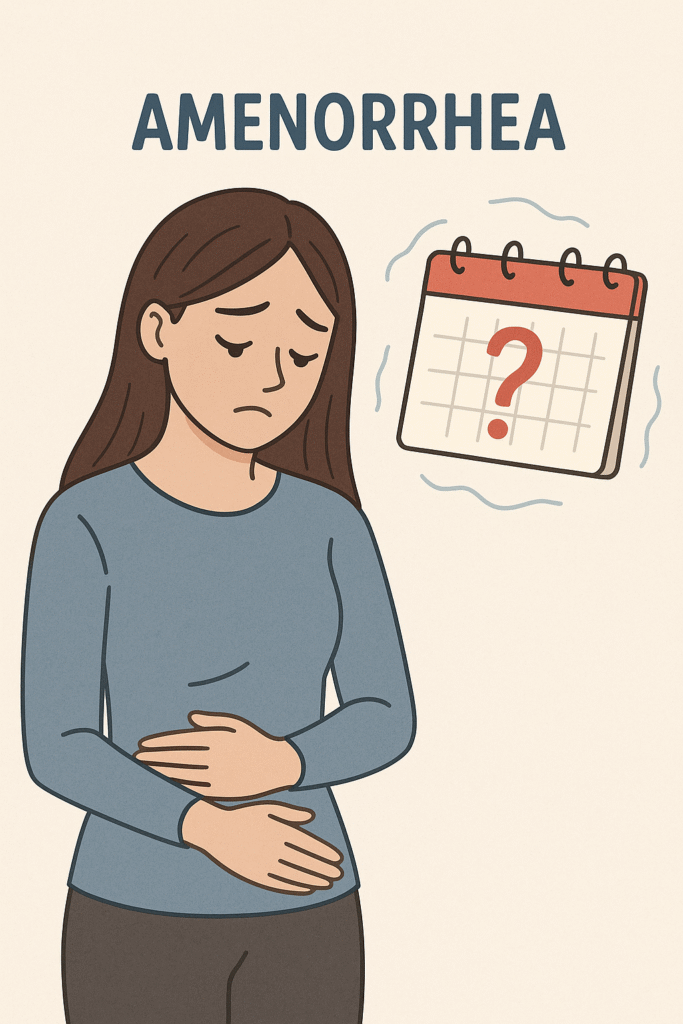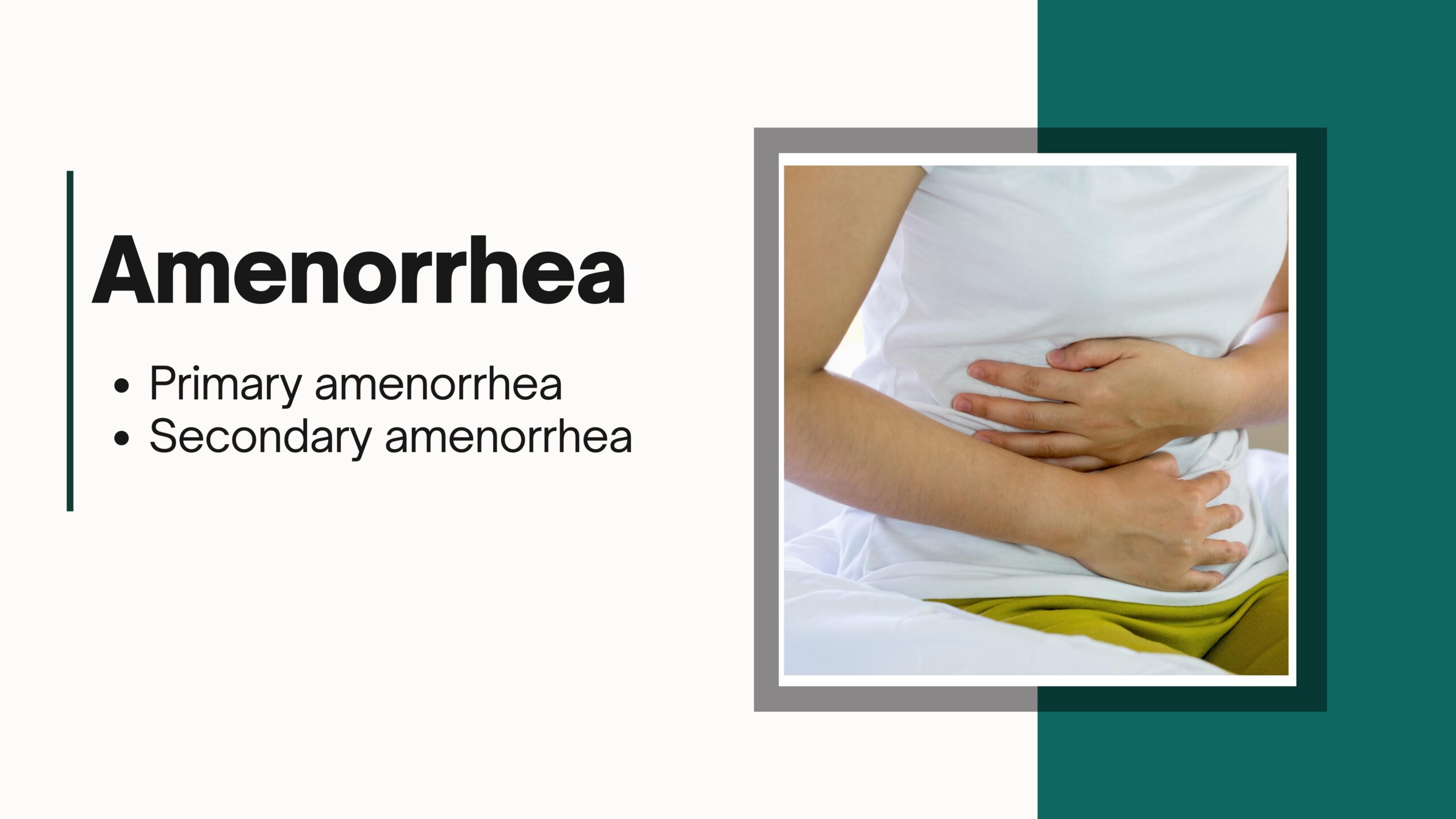Table of Contents
Definition
Amenorrhea literally means absence of menstruation. It is a condition that affects many women at different stages of life. But sometimes it is normal in like during pregnancy or menopause, it can also be a sign of an underlying health problems when it occurs unexpectedly. Early diagnosis can help prevent complications and restore hormonal balance.
It is symptom and not a disease. Overall prevalence of pathologic amenorrhea is about 3-4 %.
PRIMARY AMENORRHEA
Definition
A young girl who has not yet menstruated at the age of 16 years is having primary amenorrhea rather than delayed menarche. It may result from genetic conditions, hormonal imbalances, or structural abnormalities in her reproductive system.
SECONDARY AMENORRHEA
Definition
It is the absence of menstruation for 6 months or more in a women in who earlier had normal menstruation. It may be caused by lifestyle factors, stress, certain medical conditions, or hormonal disturbances.

Cause
Cause of primary amenorrhea are grouped as follows:
Physiological Causes
Pregnancy
Breastfeeding
Menopause
Lifestyle Factors
Extravagant physical exercise (common in athletes)
Harsh stress or emotional trauma
Significant weight loss or eating disorders such as anorexia
Medical Conditions
Polycystic Ovarian Syndrome (PCOS)
Thyroid dysfunction (hypothyroidism or hyperthyroidism)
Tumors of pituitary gland (e.g., prolactinoma)
Premature ovarian insufficiency
Chronic illnesses or diabetes
Structural Problems
Uterine scarring (Asherman’s syndrome)
Congenital abnormalities (absence of vagina or uterus)
Symptoms and Signs
The primary symptom is the absence of menstruation. Depending on the cause, other symptoms may include:
Headaches or vision changes (suggestive of a pituitary issue): headache is common and sometimes vision changes also seen.
Excessive hair growth or acne (seen in PCOS): hair growth: acne on face, neck and back with excessive hair growth on face, axilla, pubic area is seen.
Hot flashes or night sweats (indicating hormonal deficiency): due to some hormonal deficiency sweating occurs at night.
Nipple discharge (due to high prolactin levels): sometimes discharge from nipples also seen.
Diagnosis
To find the cause of amenorrhea, your doctor may recommend:
Detailed medical history and physical examination
Laboratory tests, including:
FSH and LH
Thyroid hormones
Prolactin levels
Estrogen levels
Imaging studies, such as:
Pelvic ultrasound to examine reproductive organs
MRI of brain (if a pituitary tumor is suspected)
Treatment
Treatment depends on the underlying cause:
Lifestyle changes: for stress, weight management, or over-exercise changes in lifestyle like early to bed and early to rise, healthy diet plan, pollution free environment.
Medications like hormonal therapy or thyroid supplements
Treatment of underlying conditions such as PCOS or pituitary disorders
Surgical interventions in rare cases (e.g., uterine adhesions): it is very rare, most of the cases are cure by the medication.
The goal is to reimpose normal menstrual cycles and prevent complications like infertility or bone loss.
Natural Ways to Support Hormonal Balance
Disclaimer: These are common suggestions. Always ask a healthcare provider before making changes.
1. Keep up a Healthy Weight
Abrupt weight loss or gain can disrupt hormones. Take balanced meals rich in whole foods.
2. Manage Stress
Chronic stress alters your hypothalamus. Attempt yoga, journaling, or guided meditation.
3. Apply Herbal Remedies
Vitex (Chasteberry): Maintains progesterone levels.
Maca Root: Boosts total hormone health.
Cinnamon: May help insulin sensitivity in PCOS-related amenorrhea.
4. Reduce Excessive Exercise
Overtraining may suppress reproductive hormones.
5. Ensure Nutrient Sufficiency
Especially iron, zinc, magnesium, & B-vitamins.
Complications
If left untreated, then amenorrhea can lead to:
Infertility
Osteoporosis due to moderate estrogen
Psychological distress
When to See a Doctor
You should ask a healthcare professional if:
You have not had your first period by age 15
You have missed three or more periods in a row
You experience other regarding symptoms like hair growth, vision changes, or hot flashes.
FAQs About Amenorrhea
Q. Can only stress cause amenorrhea?
Yes, high cortisol levels from chronic stress can upset your menstrual cycle.
Q. How long is too long absence a period?
More than 3 consecutive months without menses warrants a medical evaluation.
Q. Is amenorrhea curable?
Often yes—especially when caused by lifestyle or hormonal problems. With proper care, cycles may return.
Conclusion
Amenorrhea is not a disease, it’s a symptom. Whether it’s due to lifestyle, hormonal imbalances, or medical conditions. With the correct diagnosis and treatment, most cases can be managed effectively, allowing you to recover your health and peace of mind.
